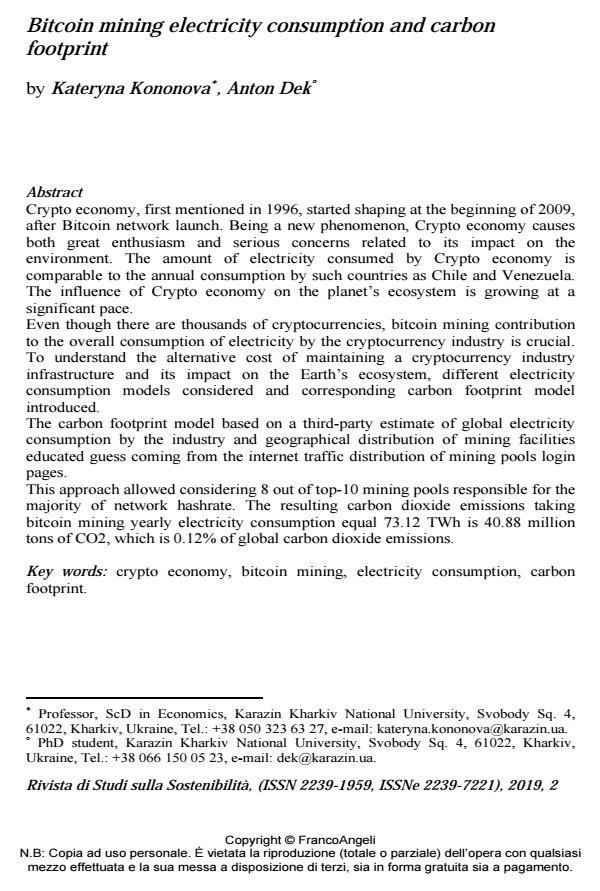Bitcoin mining electricity consumption and carbon footprint
Journal title RIVISTA DI STUDI SULLA SOSTENIBILITA'
Author/s Kateryna Kononova, Anton Dek
Publishing Year 2020 Issue 2019/2
Language English Pages 16 P. 73-88 File size 527 KB
DOI 10.3280/RISS2019-002007
DOI is like a bar code for intellectual property: to have more infomation
click here
Below, you can see the article first page
If you want to buy this article in PDF format, you can do it, following the instructions to buy download credits

FrancoAngeli is member of Publishers International Linking Association, Inc (PILA), a not-for-profit association which run the CrossRef service enabling links to and from online scholarly content.
Crypto economy, first mentioned in 1996, started shaping at the beginning of 2009, after Bitcoin network launch. Being a new phenomenon, Crypto economy causes both great enthusiasm and serious concerns related to its impact on the environment. The amount of electricity consumed by Crypto economy is comparable to the annual consumption by such countries as Chile and Venezuela. The influence of Crypto economy on the planet’s ecosystem is growing at a significant pace. Even though there are thousands of cryptocurrencies, bitcoin mining contribution to the overall consumption of electricity by the cryptocurrency industry is crucial. To understand the alternative cost of maintaining a cryptocurrency industry infrastructure and its impact on the Earth’s ecosystem, different electricity consumption models considered and corresponding carbon footprint model introduced. The carbon footprint model based on a third-party estimate of global electricity consumption by the industry and geographical distribution of mining facilities educated guess coming from the internet traffic distribution of mining pools login pages. This approach allowed considering 8 out of top-10 mining pools responsible for the majority of network hashrate. The resulting carbon dioxide emissions taking bitcoin mining yearly electricity consumption equal 73.12 TWh is 40.88 million tons of CO2, which is 0.12% of global carbon dioxide emissions.
Keywords: Crypto economy, bitcoin mining, electricity consumption, carbon footprint.
- Bevand M. (2017). Electricity consumption of Bitcoin: a market-based and technical analysis. -- Retrieved from: http://blog.zorinaq.com/bitcoin-electricity-consumption/#fnref:refD:1.
- Bitcoin Block Explorer, BTC (2019). -- Retrieved from: https://btc.com/.
- Bitcoin Energy Consumption Index, BECI (2019). -- Retrieved from: https://digiconomist.net/bitcoin-energy-consumption.
- Blockchain (2019). -- Retrieved from: https://www.blockchain.com/en/btc/tx/4a5e1e4baab89f3a32518a88c31bc87f618f76673e2cc77ab2127b7afdeda33b?show_adv=true.
- BP (2018). BP Statistical Review of World Energy. 67th Edition, p. 49. -- Retrieved from: https://www.bp.com/content/dam/bp/business-sites/en/global/corporate/pdfs/energy-economics/statistical-review/bp-stats-review-2018-full-report.pdf.
- Cambridge Bitcoin Electricity Consumption Index, CBECI (2019). -- Retrieved from: https://cbeci.org/.
- Cambridge Centre for Alternative Finance (2018). 2nd Global Cryptoasset Benchmarking Study. -- Retrieved from: https://www.jbs.cam.ac.uk/faculty-research/centres/alternative-finance/publications/2nd-global-cryptoasset-benchmark-study/.
- Coinshares (2019). The Bitcoin Mining Network. -- Retrieved from: https://coinshares.co.uk/wp-content/uploads/2019/06/MiningWhitepaperJun2019FinalForeword.pdf.
- De Vries A. (2018). Bitcoin’s Growing Energy Problem. -- Retrieved from: https://www.researchgate.net/publication/325188032_Bitcoin's_Growing_Energy_Problem.
- Ethereum Energy Consumption Index, EECI (2019). -- Retrieved from: https://digiconomist.net/ethereum-energy-consumption.
- Hayes A. S. (2015). A Cost Production Model for Bitcoin. -- Retrieved from: http://www.economicpolicyresearch.org/econ/2015/NSSR_WP_052015.pdf.
- Krause M. J., and Tolaymat T. (2018). Quantification of energy and carbon costs for mining cryptocurrencies. -- Retrieved from: https://www.nature.com/articles/s41893-018-0152-7.pdf.
- McCook H. (2018). The cost & sustainability of Bitcoin. -- Retrieved from: https://www.academia.edu/37178295/The_Cost_and_Sustainability_of_Bitcoin_August_2018_.
- Molla R., Del Rey J. (2017). Amazon’s epic 20-year run as a public company, explained in five charts. -- Retrieved from: https://www.vox.com/2017/5/15/156 10786/amazon-jeff-bezos-public-company-profit-revenue-explained-five-charts.
- Mora C., Rollins R.L., Taladay K., Kantar M.B., Chock M.K., Shimada M., and Franklin E.C. (2018). Bitcoin emissions alone could push global warming above 2°C. -- Retrieved from: www.nature.com/articles/s41558-018-0321-8.pdf.
- O’Dwyer K.L., and Malone D. (2014). Bitcoin Mining and its Energy Footprint. -- Retrieved from: http://karlodwyer.com/publications/pdf/bitcoin_KJOD_2014.pdf.
- Reagle Jr. (1996). Trust in a cryptographic economy and digital security deposits: Protocols and policies. -- Retrieved from: http://rpcp.mit.edu/~reagle/commerce/commerce.html.
- Stoll C., Klaaßen L., and Gallersdorfer U. (2019). The Carbon Footprint of Bitcoin. -- Retrieved from: https://www.cell.com/action/showPdf?pii=S2542-4351%2819%2930255-7.
- Szabo N. (2005). Bit Gold. -- Retrieved from: https://nakamotoinstitute.org/bit-gold/.
- Vranken H. (2017). Sustainability of bitcoin and blockchains. Current Opinion in Environmental Sustainability, 28: 1-9.
- Zade M., Myklebost J., Tzscheutschler P., and Wagner U. (2019). Is Bitcoin the Only Problem? A Scenario Model for the Power Demand of Blockchains. -- Retrieved from: www.frontiersin.org/articles/10.3389/fenrg.2019.00021/full.
Kateryna Kononova, Anton Dek, Bitcoin mining electricity consumption and carbon footprint in "RIVISTA DI STUDI SULLA SOSTENIBILITA'" 2/2019, pp 73-88, DOI: 10.3280/RISS2019-002007